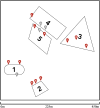Transmission dynamics of highly pathogenic avian influenza virus at the wildlife-poultry-environmental interface: A case study
- PMID: 39640906
- PMCID: PMC11617448
- DOI: 10.1016/j.onehlt.2024.100932
Transmission dynamics of highly pathogenic avian influenza virus at the wildlife-poultry-environmental interface: A case study
Abstract
Avian influenza viruses (AIVs) regularly circulate between wild and domestic bird populations. Following several high-profile outbreaks, highly pathogenic AIVs (HPAIV) with zoonotic potential have been the subject of increasing attention. While we know that HPAIV is transmitted between domestic birds, wildlife, and the environment, little is known about persistence and spillover/back at these interfaces. We integrated the test results of samples collected on and around an infected domestic poultry premise (IP) where H5N1 HPAIV was confirmed in a flock of poultry in 2022 in Southern Ontario, Canada to explore the transmission cycle of AIVs in wildlife and the environment. We sampled a captive flock of Mallards (Anas platyrhynchos) that resided on site, sediment samples collected from water bodies on site, and examined samples collected through surveillance within a 100 km radius of the IP from live wild ducks and sick and dead wildlife. We found serologic evidence of H5 exposure in the captive mallards that resided on site despite no evidence of morbidity or mortality in these birds and no PCR positive detections from samples collected at two different timepoints. Genetic material from the same H5N1 HPAIV subtype circulating in the domestic birds and from low pathogenicity avian influenza viruses were detected in wetlands on site. The results of live and sick and dead surveillance conducted within a 100 km radius confirmed that the virus was circulating in wildlife before and after IP confirmation. These results suggest that biosecurity remains the most critical aspect of minimising spillover/back risk in a virus that has been shown to circulate in asymptomatic wild birds and persist in the surrounding environment.
Keywords: Avian influenza virus; Canada; Domestic poultry; Environment; H5N1; Highly pathogenic avian influenza virus (HPAIV); Mallard; Migratory birds; Spillback; Spillover; Wild bird surveillance; Wild-domestic interface.
Crown Copyright © 2024 Published by Elsevier B.V.
Conflict of interest statement
None.
Figures






Similar articles
-
Avian influenza viruses in wild birds in Canada following incursions of highly pathogenic H5N1 virus from Eurasia in 2021-2022.mBio. 2024 Aug 14;15(8):e0320323. doi: 10.1128/mbio.03203-23. Epub 2024 Jul 16. mBio. 2024. PMID: 39012149 Free PMC article.
-
Investigating the Genetic Diversity of H5 Avian Influenza Viruses in the United Kingdom from 2020-2022.Microbiol Spectr. 2023 Aug 17;11(4):e0477622. doi: 10.1128/spectrum.04776-22. Epub 2023 Jun 26. Microbiol Spectr. 2023. PMID: 37358418 Free PMC article.
-
Genetic Evidence Supports Sporadic and Independent Introductions of Subtype H5 Low-Pathogenic Avian Influenza A Viruses from Wild Birds to Domestic Poultry in North America.J Virol. 2018 Sep 12;92(19):e00913-18. doi: 10.1128/JVI.00913-18. Print 2018 Oct 1. J Virol. 2018. PMID: 30045988 Free PMC article.
-
Origin and evolution of highly pathogenic H5N1 avian influenza in Asia.Vet Rec. 2005 Aug 6;157(6):159-64. doi: 10.1136/vr.157.6.159. Vet Rec. 2005. PMID: 16085721 Review.
-
The Arrival of Highly Pathogenic Avian Influenza Viruses in North America, Ensuing Epizootics in Poultry and Dairy Farms and Difficulties in Scientific Naming.Microb Biotechnol. 2024 Dec;17(12):e70062. doi: 10.1111/1751-7915.70062. Microb Biotechnol. 2024. PMID: 39641589 Free PMC article. Review.
Cited by
-
Examining avian influenza virus exposure in seabirds of the northwest Atlantic in 2022 and 2023 via antibodies in eggs.Conserv Physiol. 2025 Feb 24;13(1):coaf010. doi: 10.1093/conphys/coaf010. eCollection 2025. Conserv Physiol. 2025. PMID: 40007734 Free PMC article.
-
Enhancing the response to avian influenza in the US and globally.Lancet Reg Health Am. 2025 Apr 28;46:101100. doi: 10.1016/j.lana.2025.101100. eCollection 2025 Jun. Lancet Reg Health Am. 2025. PMID: 40625789 Free PMC article. Review.
-
Emerging threats of H5N1 clade 2.3.4.4b: cross-species transmission, pathogenesis, and pandemic risk.Front Cell Infect Microbiol. 2025 Jul 25;15:1625665. doi: 10.3389/fcimb.2025.1625665. eCollection 2025. Front Cell Infect Microbiol. 2025. PMID: 40786608 Free PMC article. Review.
References
-
- Canadian Food Inspection Agency (CFIA) Status of ongoing avian influenza response by province. 2024. https://inspection.canada.ca/animal-health/terrestrialanimals/diseases/r... (accessed 2024)
-
- Ramey A.M., Hill N.J., DeLiberto T.J., Gibbs S.E.J., Hopkins M.C., Lang A.S., Poulson R.L., Prosser D.J., Sleeman J.M., Stallknecht D.E., Wan X. Highly pathogenic avian influenza is an emerging disease threat to wild birds in North America. J. Wildl. Manag. 2022;86(2) doi: 10.1002/jwmg.22171. - DOI
-
- Canadian Food Inspection Agency (CFIA) Avian influenza A (H5N1) 2022 outbreak in Canada. 2022. https://ncceh.ca/resources/evidence-briefs/avian-influenza-ah5n1-2022-ou... (accessed 2024)
-
- Castillo A., Fasce R., Parra B., Andrade W., Covarrubias P., Hueche A., Campano C., Tambley C., Rojas M., Araya M., Hernández F., Bustos P., Fernández J. The first case of human infection with H5N1 avian influenza a virus in Chile. J. Travel Med. 2023;30 doi: 10.1093/jtm/taad083. - DOI - PMC - PubMed
LinkOut - more resources
Full Text Sources

